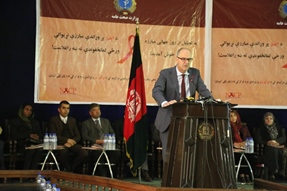 Dr. Richard Peeperkorn, WHO Representative for Afghanistan, delivered a speech at the event. Photo: WHO/H.MangalKabul 7 December 2016 – The Ministry of Public Health, WHO and partners, together with civil society and people living with HIV/AIDS, observed World AIDS Day 2016 at an event held in Kabul on 4 December with the theme “Dignity Above All”. The aim of the event was to address HIV stigma and discrimination in healthcare settings and attract more people with high-risk behaviours for HIV testing and treatment in Afghanistan to decrease the number of new infections.
Dr. Richard Peeperkorn, WHO Representative for Afghanistan, delivered a speech at the event. Photo: WHO/H.MangalKabul 7 December 2016 – The Ministry of Public Health, WHO and partners, together with civil society and people living with HIV/AIDS, observed World AIDS Day 2016 at an event held in Kabul on 4 December with the theme “Dignity Above All”. The aim of the event was to address HIV stigma and discrimination in healthcare settings and attract more people with high-risk behaviours for HIV testing and treatment in Afghanistan to decrease the number of new infections.
Speaking at the event, Deputy Minister of Public Health H.E. Dr. Najia Tariq said that the Ministry has taken important steps by developing a HIV control policy and strategy. “With the support of national and international partners and donors, we have been able to create a multi-sectoral strategy to respond to HIV transmission in our communities,” Dr. Tariq said.
“From 1989 to 2015, a total of 2086 HIV cases have been registered in the country: 83% men and 17% women, including 66 children under 15 years of age. WHO and UNAIDS estimate the number of people living with HIV to be 6,700,” she added.
Edris Azizi, representing people living with HIV, delivered a speech at the event, expressing his gratitude for the treatment and health care he has received. However, he highlighted that people living with HIV still face many problems in receiving treatment. “Discrimination is the main obstacle to our access to health facilities and services. We cannot receive treatment as other patients can receive it, sometimes hospitals and health centres ask us for more money for treatment, which we cannot afford,” he said.
 Edris Azizi, representative of group of people living with HIV, delivered a speech. Photo: WHO/H.MangalAccording to WHO estimates, of the 36.7 million people living with HIV, 18.2 million people are receiving antiretroviral treatment worldwide. In 2015, 1.1 million people died from HIV-related causes globally. There is low awareness about HIV in Afghanistan where many people living with HIV are unaware of their HIV status.
Edris Azizi, representative of group of people living with HIV, delivered a speech. Photo: WHO/H.MangalAccording to WHO estimates, of the 36.7 million people living with HIV, 18.2 million people are receiving antiretroviral treatment worldwide. In 2015, 1.1 million people died from HIV-related causes globally. There is low awareness about HIV in Afghanistan where many people living with HIV are unaware of their HIV status.
Less than 1% of Afghan women and 4% of men have ever been tested for HIV and received test results.
“In Afghanistan out of all the people living with HIV by end of 2015, only 31% knew their HIV status. Only around 22% people living with HIV are enrolled in care and among them only 60% are receiving treatment,” said Dr. Richard Peeperkorn, WHO Representative for Afghanistan.
“Vulnerable populations such as drug users, sex workers, and men having sex with men need easy access to health services and should be treated in the same way as all of us - without stigma but with respect and dignity,” he said.
Stigma and discrimination are the main barriers to prevention, treatment and care in Afghanistan. To stop HIV stigma and discrimination in healthcare settings, WHO has recently supported the Ministry of Public Health in developing of a policy on Protecting People Living with HIV from Stigma and Discrimination in Healthcare Settings.
In Afghanistan the main route of HIV transmission remains needle sharing among injecting drug users; a survey conducted in 2012 shows a 4.4% prevalence rate of HIV cases within this group. Other at-risk groups include prisoners, female sex workers, and men who have sex with men.



